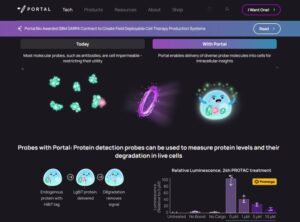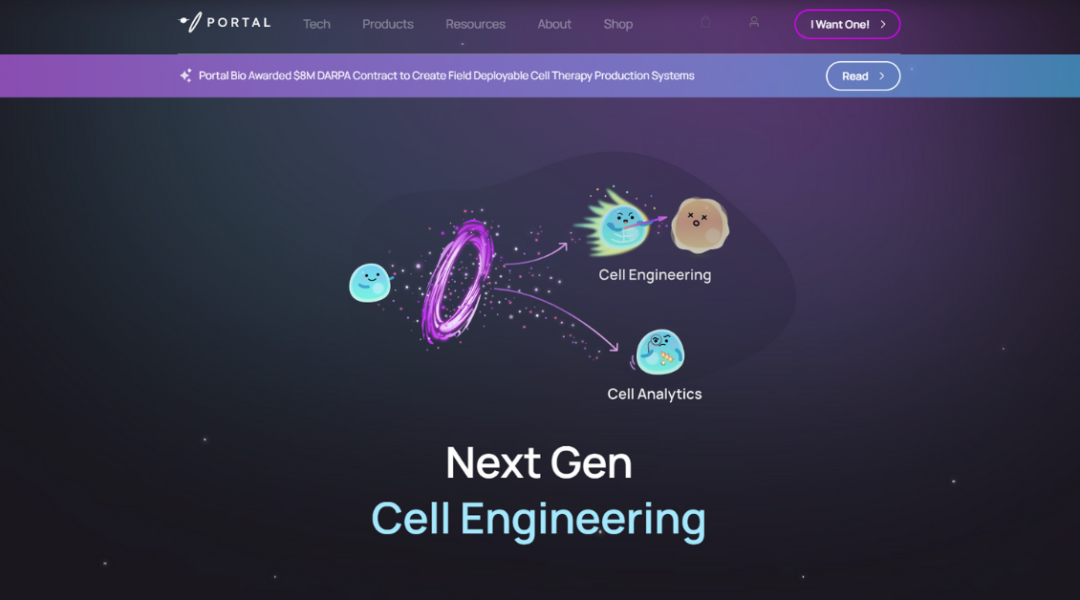Why Biotech Companies Should Use Visual Storytelling: Lessons from Portal Bio’s Cartoon Website Design
Two weeks ago, I stumbled upon a biotech website that stopped me in my tracks.
In an industry where most websites look identical—either sterile white pages with no images, or packed with diagrams so complex you need a PhD just to understand the homepage—Portal Biotechnologies dared to be different.
And it’s working brilliantly.
The Problem with Traditional Biotech Visual Storytelling
Let’s be honest: most biotech websites are boring. They fall into two categories:
- The Desert: Endless text walls with zero visual elements
- The PhD Thesis: Complex scientific diagrams that alienate 99% of visitors
I’ve spent over a decade creating animations for life science companies, and I see this pattern repeatedly. Companies invest millions in groundbreaking research, then present it in ways that make people’s eyes glaze over.
But Portal Bio took a radically different approach.
Portal Bio’s Revolutionary Approach to Biotech Visual Storytelling
When you land on Portal.bio, you’re greeted with:
Cartoon-style illustrations that feel like they’re from a children’s book
- Bright, playful colors that pop off the screen
- Simple visual metaphors that make complex science instantly understandable
The first time I saw it, I thought: “Finally! I understand what they do!”
And I’m not alone. This approach has helped Portal Bio achieve remarkable results.
The Business Case for Visual Simplicity in Biotech
Here’s what Portal Bio’s playful approach has accomplished:
Impressive Funding Results
- Successfully raised $7 million in funding
- Attracted investors who “get it” immediately
Industry Partnerships
- Working with 7 of the top 10 pharmaceutical companies
- Built trust with major players despite unconventional design
Enhanced Understanding
- Made intracellular delivery technology accessible to non-scientists
- Reduced time-to-understanding from minutes to seconds
Why Biotech Visual Storytelling Works: The Science Behind Simplicity
1. Cognitive Load Reduction
Our brains process visual information 60,000 times faster than text. When you simplify complex concepts into cartoon-style visuals, you’re literally making it easier for people’s brains to understand your science.
2. Emotional Connection
Cartoon-style illustrations trigger positive emotional responses. They remind us of learning as children—when everything was new and exciting. This emotional state makes people more receptive to new information.
3. Memorable Messaging
Simple, colorful visuals stick in our memory far longer than complex diagrams. When an investor remembers your company three months later, it’s often because of that unique visual approach.
Common Objections to Cartoon-Style Biotech Visual Storytelling
I often hear these concerns from biotech executives:
“But investors want serious stuff, not cartoons!”
Really? Portal Bio’s $7 million funding round suggests otherwise. What investors actually want is to understand your technology quickly so they can make informed decisions.
“Won’t we look unprofessional?”
There’s nothing unprofessional about clear communication. In fact, the ability to explain complex science simply demonstrates true mastery of your subject matter.
“Our science is too complex for simple visuals”
Portal Bio’s intracellular delivery technology is incredibly complex. Yet they found ways to visualize it that anyone can understand. If they can do it, so can you.
How to Implement Effective Biotech Visual Storytelling
1. Start with Your Core Message
What’s the one thing people need to understand about your technology? Build your visual story around that central concept.
2. Use Metaphors Your Audience Knows
Portal Bio uses visual metaphors that relate to everyday experiences. Find parallels between your science and things people already understand.
3. Test with Non-Scientists
Show your visuals to people outside your field. If they can explain your technology back to you, you’ve succeeded.
4. Maintain Scientific Accuracy
Simplification doesn’t mean dumbing down. Your visuals should be scientifically accurate while being visually accessible.
5. Create Visual Consistency
Develop a visual language that’s uniquely yours. Portal Bio’s cartoon style is instantly recognizable and memorable.
Real-World Examples of Successful Biotech Visual Storytelling
Beyond Portal Bio, other companies are embracing visual simplicity:
- BioNTech used simple animations to explain mRNA technology during the pandemic
- Moderna created accessible infographics that helped the public understand vaccine development
- CRISPR companies use visual metaphors of “molecular scissors” to explain gene editing
The ROI of Investing in Visual Communication
Companies that invest in clear visual communication see:
- Faster investor meetings (less time explaining, more time discussing potential)
- Higher engagement rates on websites and social media
- Better talent recruitment (candidates understand and get excited about your mission)
- Increased media coverage (journalists can easily explain your technology)
Making the Shift: Your Next Steps in Biotech Visual Storytelling
1. Audit Your Current Materials
Look at your website, pitch deck, and marketing materials. How long does it take someone to understand what you do?
2. Identify Complexity Barriers
Where do people get confused? These are your opportunities for visual simplification.
3. Start Small
You don’t need to redesign everything at once. Start with one key diagram or explanation.
4. Measure the Impact
Track metrics like time-on-site, investor meeting conversions, and recruitment success.
The Future of Biotech Communication
The biotech companies that will win in the next decade are those that can communicate their science effectively to diverse audiences.
Portal Bio has shown us that biotech visual storytelling doesn’t have to be boring or complex. By embracing simplicity and creativity, they’ve made their science accessible to everyone—from investors to potential partners to curious visitors.
A Personal Reflection on Visual Communication
Kids learn fast. They’re curious. They love to understand.
Maybe that’s why Portal Bio’s approach works so well. It taps into that childlike curiosity we all still have. It makes learning fun again.
When I show my own children animations of how medicines work in the body, they get it immediately. They ask questions. They want to know more.
Shouldn’t we aim for that same engagement with our adult audiences?
The Bottom Line: Should Biotech Embrace Kid-Friendly Design?
The evidence is clear. Portal Bio’s playful, accessible approach has led to:
- Significant funding success
- Major pharmaceutical partnerships
- Widespread understanding of their technology
The question isn’t whether we should make our science more accessible.
The question is: Can we afford not to?
Ready to Transform Your Biotech Visual Storytelling?
At Life Science Animation, we specialize in turning complex science into clear, engaging visual stories. Whether you need animations, illustrations, or a complete visual strategy, we help biotech companies communicate with clarity and impact.
Contact us to discuss how we can help you tell your science story more effectively.
What do you think? Should more biotech companies embrace playful, accessible design? Share your thoughts in the comments below.
Disclaimer: This article is an independent analysis of Portal Biotechnologies’ visual communication strategy. Life Science Animation has no affiliation with Portal Bio and was not involved in creating their website or visual materials.

Portal Bio’s intracellular probe platform delivers detection molecules into live cells, enabling real-time measurement of protein levels and degradation using HiBiT-tagged assays and luminescence readouts.

